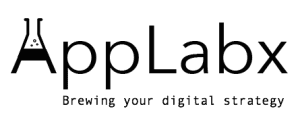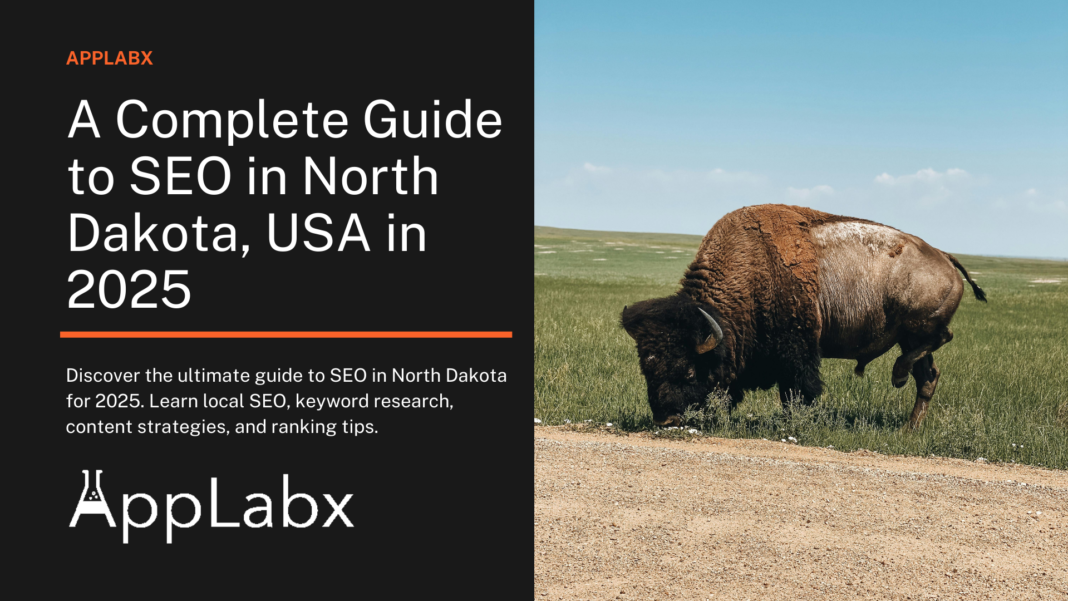Key Takeaways
- Local SEO is essential – Optimizing Google Business Profile, local keywords, and citations helps North Dakota businesses rank higher in local searches.
- Content and keywords drive success – Creating high-quality, locally relevant content with strategic keyword research boosts search visibility and engagement.
- SEO is evolving – Businesses must adapt to AI-driven search, voice search, and technical SEO improvements to stay competitive in 2025 and beyond.
In today’s digital-first world, search engine optimization (SEO) is an essential part of any successful online marketing strategy.
As businesses across the globe adapt to the increasing reliance on search engines to find products, services, and information, SEO has become more critical than ever.
For businesses in North Dakota, a state often considered to be more rural and less densely populated than others, the importance of SEO in 2025 cannot be overstated.
With the evolution of technology, changes in consumer behavior, and the shifting algorithms of search engines like Google, mastering SEO has become even more complex and necessary for local businesses to remain competitive.

North Dakota’s unique market requires a tailored SEO strategy that incorporates local nuances, cultural elements, and specific search behaviors of consumers in the region.
While global SEO strategies are essential, local businesses in North Dakota must pay particular attention to their digital presence within the context of their specific geographic area.
The good news is that as digital marketing evolves, so too do the opportunities for businesses in North Dakota to leverage SEO to boost their online visibility, drive more traffic, and ultimately grow their business.
In 2025, SEO is not just about inserting keywords and building backlinks.
It’s about creating an exceptional user experience, leveraging emerging technologies like artificial intelligence and voice search, and staying ahead of the curve with the latest updates from Google and other search engines.
As local search continues to dominate, having a strong presence on search engines like Google will determine how easily customers in North Dakota can find your business.
Whether you operate a small retail store in Fargo, a service-based business in Bismarck, or a tech startup in Grand Forks, an effective SEO strategy can place your business at the forefront of the local market, attracting customers who are actively searching for what you offer.
This guide will walk you through the critical aspects of SEO in North Dakota in 2025.
From understanding the latest trends and technological advancements shaping the industry to implementing local SEO strategies that cater to the specific needs of North Dakota residents, this resource will provide a comprehensive roadmap for businesses looking to thrive online.
Whether you are just beginning your SEO journey or seeking to refine and enhance your existing strategy, the insights provided here will help you navigate the complexities of SEO in the modern digital landscape.
In the following sections, we will delve into why local SEO is especially important in North Dakota, how to conduct localized keyword research, the best on-page SEO tactics for your website, and the strategies that will help you build valuable backlinks.
We will also discuss the future of SEO, offering insights on emerging trends and what businesses in North Dakota should do now to stay ahead of the competition in the coming years.
For business owners in North Dakota, it’s crucial to remember that SEO isn’t a one-time task, but rather an ongoing process that evolves with changes in technology, user behavior, and search engine algorithms.
Whether you’re a local small business or an established enterprise, understanding and implementing a robust SEO strategy is no longer optional – it’s a vital aspect of staying competitive in the marketplace. In this guide, we will arm you with the knowledge and actionable steps to ensure your North Dakota-based business remains visible, relevant, and accessible to your target customers in 2025 and beyond.
But, before we venture further, we like to share who we are and what we do.
About AppLabx
From developing a solid marketing plan to creating compelling content, optimizing for search engines, leveraging social media, and utilizing paid advertising, AppLabx offers a comprehensive suite of digital marketing services designed to drive growth and profitability for your business.
AppLabx is well known for helping companies and startups use SEO to drive web traffic to their websites and web apps.
At AppLabx, we understand that no two businesses are alike. That’s why we take a personalized approach to every project, working closely with our clients to understand their unique needs and goals, and developing customized strategies to help them achieve success.
If you need a digital consultation, then send in an inquiry here.
A Complete Guide to SEO in North Dakota, USA in 2025
- Understanding SEO in 2025: Key Trends and Changes
- Local SEO: Why North Dakota Businesses Should Care
- Keyword Research for North Dakota SEO Success
- On-Page SEO for North Dakota Websites
- Content Marketing Strategies for North Dakota SEO
- Building Local Backlinks for Stronger Authority
- Measuring SEO Success in North Dakota
- The Future of SEO in North Dakota: What to Expect in 2026 and Beyond
1. Understanding SEO in 2025: Key Trends and Changes
In 2025, SEO is more dynamic than ever before, and North Dakota businesses must keep up with the latest trends to succeed online. The strategies that worked a few years ago are now less effective, and the growing influence of local search, mobile optimization, AI-driven algorithms, and voice search demands that businesses adapt quickly to remain competitive. To understand SEO in North Dakota, it’s crucial to look at the current trends shaping the SEO landscape, the unique characteristics of the local market, and how businesses can effectively optimize their online presence in this ever-evolving environment.
Key SEO Trends in 2025
As we move into 2025, several major trends are redefining the SEO landscape. Understanding these trends will help North Dakota businesses stay ahead of their competitors.
- AI and Machine Learning in SEO
- Search engines like Google are increasingly relying on AI to assess websites and content. This means that SEO is not just about traditional tactics like backlinks and keywords but also about how well content satisfies user intent.
- Example: Google’s BERT (Bidirectional Encoder Representations from Transformers) algorithm update is designed to better understand the context of words in a search query, allowing businesses to focus on creating content that matches user intent rather than just keyword optimization.
- User Experience and Core Web Vitals
- In 2025, Google’s Core Web Vitals, which focus on user experience (UX), continue to influence rankings. Page load speed, mobile responsiveness, and how engaging the content is are critical ranking factors.
- Example: A local restaurant in Fargo that invests in making their website fast, easy to navigate, and mobile-friendly will be more likely to rank higher than a competitor with a slow, outdated site.
- Voice Search Optimization
- With the growing use of voice assistants like Siri, Google Assistant, and Alexa, voice search is becoming a dominant factor in SEO. Optimizing for natural language queries and question-based searches will be critical.
- Example: A North Dakota-based HVAC company could optimize for queries like “best HVAC repair near me in Bismarck” or “how do I fix my furnace in North Dakota?”
- Video and Visual Search
- The integration of visual search tools such as Google Lens means that businesses must consider image optimization as part of their overall SEO strategy.
- Example: A local clothing store in Minot that posts high-quality images of their products with proper alt text and structured data could rank for relevant visual searches.
- E-A-T (Expertise, Authoritativeness, and Trustworthiness)
- Google’s focus on E-A-T means that businesses must demonstrate authority in their field. This includes creating expert content, obtaining reputable backlinks, and engaging in public relations to build trust.
- Example: A legal firm in Fargo could build authority by publishing informative blogs about North Dakota law, citing reputable sources, and gaining backlinks from trusted local media.
SEO’s Impact on Local Businesses in North Dakota
SEO is especially important for local businesses in North Dakota. Whether you’re a retailer in Fargo, a contractor in Bismarck, or a service provider in Grand Forks, local SEO can help you stand out in a crowded digital marketplace. The key to succeeding with SEO in North Dakota lies in leveraging local search data and targeting consumers in your region.
- The Role of Google My Business (GMB)
- Local businesses that optimize their GMB listings can appear in the local search pack (the map results) on Google. This is an essential tool for North Dakota businesses looking to capture local traffic.
- Example: A family-owned diner in Mandan that regularly updates their GMB profile with accurate hours, photos, and customer reviews will be more likely to appear at the top of search results for terms like “restaurants near me.”
- Importance of Local Keywords
- Using location-specific keywords is vital for local SEO. Including city names, neighborhoods, and regional terms in your content and meta descriptions ensures that search engines know your relevance to a specific area.
- Example: A plumbing company in Dickinson should target keywords like “emergency plumber in Dickinson, ND” or “best plumbing service in Western North Dakota.”
- Mobile Optimization for North Dakota Audiences
- Given the increasing use of smartphones, mobile optimization is crucial for local SEO. Many people use mobile devices to search for businesses while on the go, especially in rural areas like North Dakota.
- Example: A mobile-responsive website for a North Dakota RV dealer ensures customers can easily browse inventory and contact the dealership on their phones.
The Changing Landscape of Google’s Algorithms in 2025
Google’s algorithms are continually evolving to provide users with the best experience possible. In 2025, businesses in North Dakota need to understand these changes to ensure their websites remain visible on the search engine results pages (SERPs).
- Mobile-First Indexing
- Google has shifted to mobile-first indexing, meaning the mobile version of your website is considered the primary version. If your website is not mobile-friendly, your rankings could suffer.
- Example: A North Dakota real estate agency with a poorly optimized mobile site will likely be outranked by a competitor whose site is fully optimized for mobile devices.
- Featured Snippets and Position Zero
- The search for position zero, or featured snippets, is intensifying. Businesses should focus on providing concise, valuable answers to common questions within their industry to earn these coveted spots.
- Example: A landscaping service in Fargo could rank for featured snippets with content like “How to prepare your garden for North Dakota winters” if their content is structured properly.
- Search Intent and Content Optimization
- Understanding search intent is paramount. Google’s algorithms are increasingly focused on delivering results that match the user’s intent. Whether it’s informational, navigational, or transactional, creating content that aligns with these intents will improve your rankings.
- Example: If someone searches “how to install a new furnace in North Dakota,” a local HVAC company’s blog post on step-by-step furnace installation could rank highly by answering that specific question.
Adapting SEO for North Dakota’s Specific Needs
While SEO practices are largely universal, businesses in North Dakota must tailor their SEO strategies to reflect the specific needs of their region, considering factors like local search behavior, competition, and seasonal changes.
- Targeting Seasonal Search Trends
- North Dakota experiences extreme seasonal changes, which can influence search behavior. Businesses must adjust their SEO strategy to reflect seasonal needs, such as winterizing services, lawn care in the spring, or outdoor activities in the summer.
- Example: A North Dakota snow removal service should optimize for keywords related to winter, such as “snow removal in Fargo” during the colder months.
- Navigating Competition in Rural Areas
- North Dakota is less densely populated than many other states, so there may be fewer competitors in certain industries. However, businesses still need to be visible in local search results to reach their target audience effectively.
- Example: A North Dakota-based winery in a small town like Jamestown can take advantage of limited competition by targeting niche keywords like “artisan wine in Jamestown” or “North Dakota vineyards.”
- Catering to Mobile and Rural Audiences
- Given North Dakota’s vast rural landscape, many users are likely to rely on mobile searches for local services. Mobile optimization is critical to ensuring your business shows up in these searches, especially when people are traveling or on the go.
- Example: A North Dakota RV rental service should ensure their mobile site is easy to navigate for travelers looking to rent an RV during the summer months.
In summary, understanding SEO in North Dakota in 2025 requires a combination of adapting to global SEO trends and addressing the unique challenges and opportunities within the region. By focusing on local SEO, mobile optimization, search intent, and leveraging key trends like voice search and AI-driven algorithms, businesses in North Dakota can create effective SEO strategies that will improve visibility, drive traffic, and ultimately grow their online presence.
2. Local SEO: Why North Dakota Businesses Should Care
In 2025, local SEO continues to be a powerful tool for businesses in North Dakota. As more consumers turn to search engines to find products, services, and information in their local area, optimizing your online presence for local search has become an essential strategy. For businesses operating in North Dakota, local SEO helps increase visibility, drive targeted traffic, and ultimately convert more local customers. In this section, we will explore why local SEO is critical for businesses in North Dakota, how it works, and actionable strategies for leveraging local SEO effectively.
The Importance of Local SEO for North Dakota Businesses
Local SEO ensures that your business is visible to people who are actively searching for products or services in your specific location. For North Dakota businesses, focusing on local SEO can yield significant benefits, especially as consumers increasingly prefer to support local businesses.
- Targeting Local Customers
- Consumers are more likely to search for businesses “near me” or in a specific area. By optimizing your site for local search, your business is more likely to appear in relevant search results.
- Example: A bakery in Fargo that focuses on local SEO could appear in search results for “best cakes near me in Fargo” or “bakery in downtown Fargo,” attracting local customers who are actively seeking baked goods.
- Reduced Competition Compared to Larger Markets
- North Dakota, with its smaller population compared to larger states, often has less competition in certain industries. This means there are significant opportunities to rank highly in local searches, especially if you effectively optimize for local SEO.
- Example: A family-owned auto repair shop in Bismarck might face less competition in local SEO than a similar business in a larger city, giving it an edge in online visibility.
- Higher Conversion Rates
- Local SEO typically leads to higher conversion rates because users are more likely to visit a store or contact a service provider when they find relevant businesses in their local area. People prefer businesses that are easily accessible and relevant to their immediate needs.
- Example: A North Dakota landscaping company targeting local keywords such as “lawn care in Grand Forks” can attract homeowners in the area who are looking for seasonal landscaping services, resulting in higher lead generation and conversions.
- Improved Online Presence for Small Businesses
- Local SEO is especially beneficial for small businesses that may not have the same marketing budgets as larger corporations. By focusing on local SEO, small businesses can compete more effectively against larger competitors who may overlook the importance of hyper-targeted local search.
- Example: A small North Dakota coffee shop can optimize for “best coffee in Minot” or “local coffee shops in Minot” and gain visibility that larger chain coffee shops might miss.
Key Components of Local SEO for North Dakota Businesses
Local SEO requires a different approach than traditional SEO. It focuses on strategies that help businesses rank higher in local search results, making it easier for customers in specific locations to find and interact with your business.
Google My Business (GMB) Optimization
- Claim and Verify Your Google My Business Listing
- Google My Business (GMB) is one of the most powerful tools for local SEO. Having a verified GMB listing ensures your business is listed in local search results and on Google Maps.
- Example: A North Dakota hair salon that has a GMB profile listing accurate contact details, business hours, and services offered is more likely to show up when users search for “hair salon near me” in their area.
- Optimize Your GMB Profile
- Adding high-quality images, keeping business hours updated, and encouraging customers to leave reviews are essential steps for making your GMB profile more effective.
- Example: A North Dakota farm-to-table restaurant that regularly updates its GMB profile with seasonal menus, photos of dishes, and customer reviews will gain better visibility in local searches.
NAP Consistency
- Why NAP (Name, Address, Phone Number) Consistency Matters
- Consistency of your NAP information across the web is crucial for local SEO. Inconsistent or incorrect NAP details can confuse search engines and customers, potentially affecting your rankings.
- Example: A local North Dakota dentist whose address or phone number is different on directories like Yelp, Facebook, and their website could be penalized by Google. Ensuring consistency will help improve local search rankings.
- List Your Business on Relevant Local Directories
- Make sure your business is listed in local directories like Yelp, Yellow Pages, and local chamber of commerce websites, and that your NAP details match your website and GMB profile.
- Example: A North Dakota plumbing company should ensure their business is listed on local trade directories, like the North Dakota Association of Plumbing Professionals, with consistent and accurate information.
Local Keyword Optimization
- Target Local Keywords
- Optimizing for location-based keywords is critical in local SEO. Businesses should focus on incorporating city names, neighborhoods, and even local landmarks in their keywords.
- Example: A construction company in Fargo should target keywords like “home renovation in Fargo,” “construction contractors in North Dakota,” or “remodeling services in Fargo” to ensure their website is visible to local customers.
- Use Long-Tail Keywords
- Long-tail keywords are more specific and typically have higher conversion potential. In local SEO, long-tail keywords that reflect user intent (e.g., “best lawn care service in Bismarck” or “North Dakota auto detailing near me”) are crucial for local targeting.
- Example: A North Dakota-based home cleaning service can rank for long-tail keywords such as “affordable house cleaning in Minot” or “cleaning services for vacation homes in North Dakota.”
Local Content Creation
- Develop Locally Relevant Content
- Creating content that is relevant to your community is an effective way to improve local SEO. Write blog posts, articles, or guides that address local interests, events, or news.
- Example: A North Dakota brewery could write a blog post about “The Best Craft Beers in North Dakota” or “Events at Local Breweries in Fargo,” driving both local traffic and engagement.
- Feature Local Testimonials and Case Studies
- Including customer testimonials from local clients or case studies that highlight your work within the community helps build trust and relevance in local search results.
- Example: A North Dakota construction firm could feature customer testimonials on their website, showcasing how they have helped clients in specific towns or neighborhoods, further enhancing their local SEO efforts.
The Role of Reviews and Social Proof in Local SEO
- Encourage Customer Reviews
- Positive customer reviews are one of the most powerful ranking factors for local SEO. Businesses should actively encourage satisfied customers to leave reviews on Google, Yelp, and other relevant platforms.
- Example: A North Dakota fitness center that encourages clients to leave positive reviews on its Google My Business profile will improve its rankings for local searches like “best gym in Fargo.”
- Respond to Reviews
- Engaging with reviews—both positive and negative—shows that you care about customer feedback. It can also influence local rankings.
- Example: A North Dakota car dealership that responds to customer reviews with personalized messages will improve customer trust and demonstrate good customer service.
- Leverage Social Media for Local Engagement
- Social media platforms are crucial for local SEO, as they help build brand awareness, drive engagement, and provide an additional channel for reviews and testimonials.
- Example: A local North Dakota boutique that shares updates about new products, local events, or special offers on platforms like Facebook and Instagram will gain more visibility within its community.
Building Local Backlinks
- Focus on Local Partnerships
- Building backlinks from reputable local sources, such as local media outlets, other businesses, or community organizations, is crucial for improving local SEO.
- Example: A North Dakota event venue could partner with local wedding planners and get backlinks from their websites, helping to boost both businesses’ SEO.
- Sponsor Local Events or Charities
- Local sponsorships and charity events not only improve your brand’s image but can also earn valuable backlinks from local news sites and blogs.
- Example: A North Dakota real estate company that sponsors a local charity run might receive backlinks from local news websites and nonprofit organizations, increasing local visibility.
Measuring the Success of Your Local SEO Efforts
- Track Local Rankings and Traffic
- Use tools like Google Analytics and Google Search Console to track how well your website is performing in local search results. Monitor local traffic, keyword rankings, and conversion rates to measure success.
- Example: A North Dakota roofing company can track traffic from specific locations like Fargo or Bismarck to gauge the effectiveness of their local SEO campaign.
- Adjust Strategies Based on Data
- If certain keywords or tactics aren’t producing results, refine your approach. SEO is an ongoing process, and continuous optimization is crucial for sustained success.
- Example: A North Dakota cleaning service might find that targeting specific neighborhoods (e.g., “house cleaning in West Fargo”) brings more leads, allowing them to refine their strategy accordingly.
In conclusion, local SEO is an indispensable tool for businesses in North Dakota in 2025. By optimizing for local search, improving online visibility, and targeting relevant local keywords, businesses can not only drive more traffic but also build stronger relationships with their community. Whether you’re a small family-owned business or a larger enterprise, implementing effective local SEO strategies can significantly enhance your presence in North Dakota’s competitive digital landscape.
3. Keyword Research for North Dakota SEO Success
Keyword research is one of the cornerstones of SEO, and it becomes even more crucial for businesses in North Dakota when trying to dominate local search results. In 2025, keyword research is no longer just about identifying high-traffic terms; it’s about finding keywords that align with your audience’s intent and local search behaviors. For businesses in North Dakota, the right keyword strategy can mean the difference between appearing on page one of Google or getting lost in a sea of competition.
In this section, we will explore the best practices for conducting keyword research that is specifically tailored to the needs of North Dakota businesses. We’ll also dive into tools and strategies that will help you target the most relevant and profitable keywords for your SEO efforts.
Why Keyword Research Matters for North Dakota Businesses
Effective keyword research is essential for any business looking to gain visibility in search engine results. In North Dakota, local SEO is a major part of a successful digital marketing strategy, and selecting the right keywords for your location-specific audience is key to driving traffic to your website.
- Targeting Relevant Audiences
- Keyword research helps businesses identify what their potential customers are searching for. For North Dakota businesses, this means finding keywords that resonate with local search intent.
- Example: A North Dakota landscaping business targeting residential customers might focus on keywords like “lawn care services in Fargo” or “tree removal Bismarck.”
- Ranking for the Right Keywords
- Using keywords that accurately reflect your product or service offerings will help you rank for searches that are most likely to convert. Localized keyword targeting can help you dominate searches in specific North Dakota cities or regions.
- Example: A bakery in Grand Forks that optimizes for “best cupcakes in Grand Forks” will rank higher in local search results for that specific term compared to a broader keyword like “best cupcakes.”
- Increased Visibility and Local Traffic
- By researching the terms local customers are searching for, businesses can boost their visibility in highly competitive local markets. This targeted traffic is more likely to lead to conversions and sales.
- Example: A Bismarck-based plumbing company optimizing for “24/7 plumber in Bismarck” is more likely to appear in local search results when a potential customer searches for an emergency plumber nearby.
Types of Keywords for North Dakota SEO
When conducting keyword research for your North Dakota-based business, it’s essential to understand the different types of keywords you can target. Not all keywords are equal, and targeting a combination of these types will give you a comprehensive keyword strategy.
Local Keywords
- What are Local Keywords?
- Local keywords are terms that include a geographic location, such as city names, neighborhoods, or even nearby landmarks. These keywords help businesses appear in searches for people looking for products and services near them.
- Example: A North Dakota law firm targeting the “family lawyer in Fargo” keyword is more likely to attract local clients compared to simply targeting “family lawyer” without a location.
- Why Local Keywords Are Crucial
- For businesses in North Dakota, local keywords are vital for attracting customers who are searching specifically for services in their area.
- Example: A roofing company in North Dakota could focus on keywords like “roof replacement in Bismarck” or “affordable roofing services in North Dakota” to ensure they appear in local search results.
Long-Tail Keywords
- What Are Long-Tail Keywords?
- Long-tail keywords are longer and more specific phrases that typically have lower search volume but higher conversion rates. These keywords capture specific user intent, making them highly valuable for businesses looking to target niche audiences.
- Example: Instead of just targeting “auto repair,” a North Dakota auto repair shop might target “affordable auto repair services in Minot” or “best transmission repair in Fargo.”
- Why Long-Tail Keywords Matter
- Long-tail keywords are easier to rank for, and they capture users who have a clearer intent. For businesses in North Dakota, focusing on these keywords can help attract highly relevant traffic.
- Example: A small local yoga studio in Bismarck could target long-tail keywords like “beginner yoga classes in Bismarck” or “yoga for stress relief in North Dakota.”
Service-Specific Keywords
- What Are Service-Specific Keywords?
- These are keywords that reflect the specific services your business offers. They’re often combined with location-based terms for maximum relevance.
- Example: A plumbing company in Fargo could use service-specific keywords like “leak detection in Fargo” or “emergency plumbing services in North Dakota.”
- Why Service-Specific Keywords are Essential
- Service-specific keywords ensure that your business is found by customers looking for a very particular service you offer. It also helps search engines understand exactly what you specialize in.
- Example: A North Dakota landscaping company might target service-specific keywords like “yard drainage solutions in Fargo” or “hardscaping services in Bismarck.”
Branded Keywords
- What Are Branded Keywords?
- Branded keywords include the name of your business or any variations of it. These keywords are crucial for building brand awareness and attracting users who are already familiar with your company.
- Example: If you own a well-known restaurant in Grand Forks, targeting keywords like “Joe’s Pizza Grand Forks” or “Joe’s Pizza delivery” can help attract people who are specifically searching for your brand.
- Importance of Branded Keywords
- While branded keywords typically have lower competition, they can still play an important role in driving traffic and building brand recognition in your local community.
- Example: A North Dakota-based furniture store can use “John’s Furniture Fargo” to appear when customers specifically look for their brand.
Tools and Techniques for Effective Keyword Research
To conduct effective keyword research, businesses in North Dakota can leverage a variety of tools and techniques that help identify high-value keywords. These tools allow you to explore search volume, competition, and search trends, making it easier to make data-driven decisions.
Google Keyword Planner
- Overview of Google Keyword Planner
- Google Keyword Planner is a free tool that provides valuable insights into search volume and competition levels for different keywords.
- How to Use It for North Dakota SEO
- Use Google Keyword Planner to find local keyword variations and understand search trends in North Dakota.
- Focus on keyword phrases with medium to low competition that are relevant to your location and services.
- Example: A North Dakota-based contractor could input “remodeling services” in Google Keyword Planner to find more specific phrases like “kitchen remodeling Bismarck” or “bathroom remodel Fargo.”
SEMrush
- Overview of SEMrush
- SEMrush is a paid tool that provides in-depth keyword research data, including competition analysis and keyword trends. It’s great for identifying both short-tail and long-tail keywords for local SEO.
- How to Use SEMrush for North Dakota SEO
- Use SEMrush to find competitors’ keywords and target gaps in the market.
- Focus on identifying high-volume keywords that have the potential for local targeting, especially for underserved areas of North Dakota.
- Example: A North Dakota real estate agent could use SEMrush to find keywords like “best real estate agent in Fargo” or “North Dakota real estate market trends” that have high potential but low competition.
Google Trends
- Overview of Google Trends
- Google Trends shows the popularity of search terms over time. It can help you identify seasonal trends, local interest, and keyword performance.
- How to Use Google Trends for North Dakota SEO
- Look for seasonal patterns specific to North Dakota, such as winter services or summer activities, and adjust your keyword strategy accordingly.
- Track keywords for different cities in North Dakota to understand regional demand.
- Example: A North Dakota-based HVAC company could track terms like “heating services in North Dakota” or “air conditioning repair Fargo” to predict seasonal demand and adjust marketing efforts.
Competitor Analysis
- Why Competitor Analysis Matters
- By analyzing your competitors’ keyword strategies, you can uncover valuable opportunities to outrank them.
- How to Conduct Competitor Keyword Research
- Identify local competitors and analyze their websites to discover which keywords they are ranking for.
- Use tools like SEMrush, Ahrefs, or SpyFu to identify competitors’ keywords and target them yourself.
- Example: A North Dakota auto repair shop could look at a competitor’s site to identify keywords like “auto maintenance Fargo” and target them if they are not already ranking well for those terms.
Putting Keyword Research into Action
Once you have gathered your list of keywords, it’s time to integrate them into your SEO strategy. Here’s how you can apply your keyword research effectively.
- Optimize On-Page Elements
- Incorporate your target keywords into title tags, meta descriptions, header tags, and content to improve relevancy and rankings.
- Example: A local North Dakota hair salon could optimize its homepage by adding the keyword “best hair salon in Fargo” in the title tag and meta description.
- Create Location-Specific Landing Pages
- Create landing pages that are optimized for specific cities or regions in North Dakota to target customers in those areas.
- Example: A landscaping business could create separate pages for Fargo, Bismarck, and Grand Forks, optimizing each page with relevant location-based keywords.
- Focus on User Intent
- Ensure that the content around your keywords answers the user’s query and provides valuable information that meets their needs.
- Example: A plumbing company targeting “emergency plumber in Bismarck” should create content that answers common emergency plumbing questions and explains how their services can address these needs.
In conclusion, keyword research is a vital part of SEO success for businesses in North Dakota in 2025. By targeting local, long-tail, service-specific, and branded keywords, North Dakota businesses can increase their visibility, drive relevant traffic, and convert more customers. Using the right tools and techniques to uncover these keywords will set you on the path to SEO success, ensuring your business stands out in the competitive North Dakota market.
4. On-Page SEO for North Dakota Websites
On-page SEO is crucial for improving a website’s search engine visibility, and in 2025, it remains one of the most effective ways to rank higher in local search results. For businesses in North Dakota, optimizing on-page elements is key to attracting local customers and driving traffic. This section will explore the essential on-page SEO practices that North Dakota businesses must implement in 2025 to stay competitive and improve their search rankings.
What is On-Page SEO?
On-page SEO refers to the optimization of elements within your website to improve its search engine rankings and drive organic traffic. These elements include content, HTML source code, and multimedia like images and videos. By optimizing these factors, you can increase the relevance of your web pages and improve user experience, both of which are critical ranking factors for search engines.
- Importance of On-Page SEO for North Dakota Businesses
- Optimizing on-page SEO is particularly important for businesses targeting local customers in North Dakota. Effective on-page SEO ensures your website is visible in local searches, helping you capture valuable local traffic and boost conversions.
- Example: A North Dakota bakery that optimizes its homepage with local keywords and location-specific content will appear higher in search results when people search for “best bakery in Bismarck.”
Key Elements of On-Page SEO for North Dakota Websites
To optimize a website for on-page SEO, North Dakota businesses must focus on several critical elements. Each of these elements contributes to improving the relevance of the website and enhancing its visibility in search results.
Title Tags
- What are Title Tags?
- The title tag is the clickable headline that appears in search engine results. It’s one of the most important on-page SEO elements, as it directly influences click-through rates (CTR) and search rankings.
- Optimizing Title Tags for Local SEO
- Include primary keywords and location-specific terms in the title tag to ensure the page ranks for local searches. Keep the title under 60 characters to avoid truncation in search results.
- Example: For a Fargo-based law firm, a good title tag could be “Experienced Family Lawyer in Fargo | [Law Firm Name].”
- Best Practices
- Place primary keywords near the beginning of the title tag.
- Include your business’s name at the end if it’s a well-known brand.
- Ensure the title tag is relevant to the content on the page.
- Example: A North Dakota roofing company might use a title tag like “Reliable Roof Replacement Services in Fargo | [Company Name].”
Meta Descriptions
- What is a Meta Description?
- The meta description is a brief summary of the content on the page. It appears below the title in search results and is meant to entice users to click through to your website.
- Optimizing Meta Descriptions for Local Searches
- Write compelling meta descriptions that include both keywords and location-specific information. While meta descriptions don’t directly affect rankings, they influence CTR, which in turn impacts rankings.
- Example: For a North Dakota HVAC business, the meta description might read: “Need fast HVAC services in Fargo? [Company Name] provides expert heating and air conditioning repairs. Contact us today for a free quote!”
- Best Practices
- Keep meta descriptions under 160 characters to ensure they display fully in search results.
- Include a clear call to action (CTA).
- Focus on the unique selling points (USPs) of your business.
Header Tags (H1, H2, H3, etc.)
- What Are Header Tags?
- Header tags are HTML elements used to define headings and subheadings on a webpage. They help organize content for readers and signal to search engines the hierarchy and structure of your page’s content.
- Optimizing Header Tags for SEO
- Use only one H1 tag on each page, which should include your primary keyword and reflect the topic of the page.
- Use H2, H3, and other header tags for subheadings, ensuring they contain secondary keywords and related terms.
- Example: A North Dakota landscape design business might use:
- H1: “Expert Landscaping Services in Fargo”
- H2: “Affordable Lawn Care and Maintenance in North Dakota”
- H3: “Why Choose [Company Name] for Your Landscaping Needs?”
- Best Practices
- Use clear, descriptive headings that incorporate primary and secondary keywords.
- Organize the content with a logical structure using H2, H3, and H4 tags.
- Ensure the headers reflect the search intent of your target audience.
Content Optimization
- Creating High-Quality Content
- Content is one of the most important on-page ranking factors. To optimize your website for SEO, it’s essential to create well-written, informative, and engaging content that answers the search intent of your audience.
- Targeting Local Keywords in Content
- For North Dakota businesses, it’s important to incorporate location-based keywords throughout the content, including city names, neighborhoods, and local landmarks.
- Example: A local home cleaning service in Minot could create content targeting “home cleaning services in Minot, ND” and “affordable deep cleaning in Minot.”
- Best Practices
- Focus on creating content that answers your audience’s questions and provides value.
- Use keyword variations and related terms naturally throughout the content.
- Aim for a word count of 1,500-2,000 words for key pages to improve content depth.
Internal Linking
- What is Internal Linking?
- Internal linking refers to linking to other pages or posts within your own website. It helps users navigate your site, keeps them engaged, and boosts the SEO value of linked pages.
- Optimizing Internal Links for North Dakota SEO
- Use descriptive anchor text to link to other relevant pages on your website. Internal links should support the flow of content and guide users to additional helpful information.
- Example: A North Dakota restaurant could link from its blog post about “best local breweries in Fargo” to its menu page with an anchor text like “check out our menu.”
- Best Practices
- Use a natural, user-friendly linking structure.
- Link to high-authority pages within your site to boost their visibility.
- Avoid excessive internal linking, which can confuse search engines.
URL Structure
- What is URL Structure?
- The URL structure of your page should be clean, descriptive, and easy to read by both search engines and users. URLs that include keywords help improve your page’s relevancy and SEO.
- Optimizing URLs for Local SEO
- Ensure that the URL includes relevant keywords, including your business name and location, where appropriate.
- Example: A North Dakota plumbing company might use a URL like: “www.example.com/plumbing-services-bismarck” to rank for plumbing-related keywords in Bismarck.
- Best Practices
- Keep URLs short, simple, and easy to understand.
- Use hyphens (-) to separate words (avoid underscores).
- Include primary keywords in the URL, especially for important pages like service offerings or location-specific content.
Image Optimization
- What is Image Optimization?
- Image optimization ensures that images on your website load quickly, are properly tagged, and contribute to SEO. Well-optimized images can enhance user experience and provide additional opportunities for ranking.
- Optimizing Images for On-Page SEO
- Compress image files to reduce loading times. Large images can slow down page speed, which negatively affects user experience and SEO.
- Use descriptive alt text with relevant keywords and location-based information.
- Example: A North Dakota wedding photographer could optimize an image with alt text like “wedding photography in Fargo, North Dakota.”
- Best Practices
- Resize and compress images before uploading them to your website.
- Use alt text to describe each image, incorporating keywords related to the content.
- Add image captions where appropriate to enhance engagement.
Mobile Optimization
- Why Mobile Optimization is Critical
- With the increasing number of mobile searches, optimizing your website for mobile devices is essential for both user experience and search engine rankings. Google’s mobile-first indexing means that mobile-friendly websites are prioritized in search results.
- Best Practices for Mobile Optimization
- Use responsive design, ensuring your website automatically adjusts to fit different screen sizes.
- Optimize for fast loading times, as slow pages can negatively impact mobile users.
- Example: A North Dakota retail store should ensure that its eCommerce website works seamlessly on mobile devices, offering easy navigation, fast load times, and a smooth checkout process.
Schema Markup
- What is Schema Markup?
- Schema markup is structured data added to your website’s HTML that helps search engines better understand the content of your page. It can enhance search engine listings with rich snippets, improving visibility in search results.
- Using Schema Markup for Local SEO
- Implement local business schema markup to provide search engines with important information about your business, such as location, hours of operation, contact details, and customer reviews.
- Example: A North Dakota dentist could add local business schema markup to its homepage to display its location, phone number, and patient reviews directly in the search engine results page (SERP).
- Best Practices
- Use tools like Google’s Structured Data Markup Helper to implement schema markup.
- Ensure the structured data is accurate and up-to-date.
- Regularly check for errors using Google Search Console.
In conclusion, on-page SEO is a critical factor for North Dakota businesses to improve their online visibility, attract local customers, and increase conversions. By optimizing key elements like title tags, meta descriptions, content, and technical aspects such as URL structure and image optimization, businesses can enhance their website’s relevance, user experience, and search engine rankings. By following these best practices, North Dakota businesses can set themselves up for SEO success in 2025 and beyond.
5. Content Marketing Strategies for North Dakota SEO
Content marketing is a crucial component of any effective SEO strategy, and in 2025, it is more important than ever for North Dakota businesses to implement robust content strategies. High-quality content not only helps drive organic traffic but also plays a pivotal role in building brand authority, engaging local audiences, and improving conversions. For North Dakota businesses, creating valuable content that resonates with local search intent and reflects regional interests is key to achieving long-term SEO success.
In this section, we will explore the best content marketing strategies for North Dakota businesses in 2025, focusing on creating content that enhances SEO performance, boosts local engagement, and positions businesses as trusted authorities in their industries.
Why Content Marketing Matters for North Dakota SEO
Content marketing is essential for businesses looking to improve their SEO performance and increase local visibility. By creating high-quality, relevant content, businesses can build trust with their audience, improve user engagement, and boost rankings for local search terms. For North Dakota businesses, content marketing becomes even more critical due to the state’s unique local demographics and search behavior.
- Improved Local SEO
- Well-crafted, locally-focused content helps businesses rank for region-specific keywords, driving relevant traffic to their websites.
- Example: A North Dakota outdoor adventure company might create content about “best hiking trails in North Dakota” to target outdoor enthusiasts searching for local trails.
- Increased Audience Engagement
- Content marketing is an excellent way to engage your audience by answering their questions, solving their problems, and offering helpful information related to your products or services.
- Example: A North Dakota-based farm-to-table restaurant could create blog posts on “sustainable farming in North Dakota” to connect with environmentally conscious customers.
- Enhanced Brand Authority
- Publishing informative, well-researched content helps establish your business as an authority in your industry. This can foster trust and increase the likelihood that visitors will return or make a purchase.
- Example: A North Dakota law firm could publish articles on topics like “North Dakota divorce laws” to build credibility and trust with potential clients.
Effective Content Types for Local SEO in North Dakota
Different types of content can be highly effective in boosting your local SEO efforts. By focusing on content types that are both valuable to your audience and optimized for SEO, North Dakota businesses can improve visibility and drive traffic.
Blog Posts
- What are Blog Posts?
- Blog posts are one of the most versatile and effective content types for improving SEO. They provide an opportunity to cover a range of topics related to your business while also integrating relevant keywords.
- Optimizing Blog Content for Local SEO
- Focus on creating content that answers local search queries, provides solutions to problems, and incorporates location-specific keywords.
- Example: A North Dakota HVAC company could write a blog post titled “How to Prepare Your Home for North Dakota’s Harsh Winters” to target local homeowners looking for winterization tips.
- Best Practices
- Include local keywords and geographic terms naturally throughout the post.
- Maintain a consistent posting schedule to keep your website fresh and relevant.
- Use internal links to guide visitors to other important pages on your site.
- Incorporate multimedia like images and videos to enhance user experience.
Case Studies and Customer Testimonials
- What are Case Studies and Testimonials?
- Case studies showcase how your products or services have helped customers solve specific problems. Testimonials offer feedback from customers about their experiences with your business.
- Leveraging Case Studies for Local SEO
- Case studies can be tailored to highlight local clients and the results your business has delivered in North Dakota. Testimonials that mention local areas or neighborhoods can also enhance local relevance.
- Example: A North Dakota construction company might create a case study detailing a project in Fargo, including specific challenges and how their team overcame them.
- Best Practices
- Ensure that case studies are detailed and include measurable outcomes.
- Use local language and geographic references to connect with a regional audience.
- Collect and display authentic customer testimonials, ideally with customer names and locations.
Local Guides and Resource Pages
- What are Local Guides and Resource Pages?
- Local guides and resource pages offer valuable information specific to a region, such as recommendations for activities, businesses, or services in a particular area. These pages are perfect for targeting location-based searches.
- Creating Local Guides for SEO
- Develop content that provides value to local audiences by addressing common questions and concerns, such as “Where to eat in Fargo” or “Top 5 things to do in Minot.”
- Example: A North Dakota tourism business could create a guide on “The Best Outdoor Activities in North Dakota” to attract visitors interested in exploring the state’s natural beauty.
- Best Practices
- Include relevant keywords and phrases naturally throughout the content.
- Provide actionable information that your audience can use, such as local tips, services, and recommendations.
- Use local landmarks and geographical terms to improve relevance for regional searchers.
Video Content
- What is Video Content?
- Video content is an increasingly popular and effective form of marketing that can significantly enhance user engagement and SEO performance. Videos are engaging, shareable, and can be easily optimized for search engines.
- Optimizing Videos for Local SEO
- Create videos that highlight local events, services, or businesses in North Dakota. Include location-specific keywords in titles, descriptions, and tags.
- Example: A North Dakota construction company might create a video tour of a recent project in Fargo, showcasing their expertise while incorporating location-based keywords in the title and description.
- Best Practices
- Keep videos short, informative, and relevant to your audience’s needs.
- Include a call to action (CTA) encouraging viewers to visit your website or contact your business.
- Optimize video titles and descriptions with local keywords.
- Host videos on platforms like YouTube and embed them on your website for increased visibility.
Infographics and Visual Content
- What Are Infographics and Visual Content?
- Infographics and other visual content types like charts, graphs, and illustrations are highly engaging and easy to share. They present information in a digestible format and are effective for explaining complex topics.
- Creating Infographics for Local SEO
- Infographics that highlight local trends, statistics, or topics related to North Dakota can attract local audiences and encourage shares.
- Example: A North Dakota energy company might create an infographic on “Energy Saving Tips for North Dakota Winters” and share it through social media to increase brand visibility.
- Best Practices
- Ensure the infographic is visually appealing, easy to understand, and shares valuable information.
- Include local keywords in the text and file names of your infographics for SEO optimization.
- Promote your infographics on social media and other platforms to maximize reach.
Content Distribution and Promotion
Creating great content is only part of the equation. To maximize its effectiveness, businesses must actively promote their content to reach a wider audience. Content distribution strategies are essential for increasing visibility, engagement, and local authority.
Social Media Promotion
- Using Social Media to Promote Content
- Social media is an essential channel for promoting content, especially in local markets like North Dakota. Share blog posts, videos, and infographics on platforms like Facebook, Instagram, and LinkedIn to engage with your local audience.
- Example: A North Dakota winery might share a blog post about “How to Pair Wine with North Dakota Cuisine” on Facebook and Instagram to engage with local wine lovers.
- Best Practices
- Create platform-specific content tailored to your audience.
- Use location tags and hashtags to increase discoverability in local searches.
- Engage with your followers by responding to comments and sharing user-generated content.
Email Marketing
- Using Email Marketing to Promote Content
- Email marketing is an excellent way to directly reach your local audience and drive traffic to your content. Send newsletters with links to new blog posts, videos, or case studies to keep your audience informed.
- Example: A North Dakota-based auto repair shop could send an email about “Preparing Your Car for North Dakota’s Winter Weather” with links to relevant blog posts on their website.
- Best Practices
- Personalize email content based on the recipient’s preferences and past interactions with your business.
- Segment your email list to target specific customer groups (e.g., residential vs. commercial clients).
- Include clear CTAs to guide recipients to your website.
Influencer Partnerships and Guest Blogging
- Collaborating with Local Influencers and Bloggers
- Partnering with local influencers or bloggers can help increase your content’s reach and boost brand awareness. Look for influencers who have a strong local following and align with your business values.
- Example: A North Dakota fashion brand might collaborate with local influencers to promote new products through blog posts or social media campaigns.
- Best Practices
- Choose influencers and bloggers who have a genuine connection with your target audience.
- Create mutually beneficial partnerships that align with both parties’ goals.
- Include links to your website or landing pages in guest posts to improve SEO.
Measuring Content Performance
After implementing content marketing strategies, it is essential to measure the performance of your content to understand what works and refine your approach over time.
- Using Google Analytics for Content Performance
- Google Analytics can track key metrics such as traffic, bounce rates, and conversion rates. Monitor these metrics to assess how well your content is performing and make adjustments as needed.
- Key Metrics to Track
- Organic traffic to content pages.
- Average time spent on content pages.
- Bounce rates, especially on local pages.
- Conversion rates from content pages to lead forms or product purchases.
- Best Practices
- Regularly review content performance and make data-driven adjustments.
- Focus on high-converting content to replicate its success in future campaigns.
- Continuously optimize content for SEO based on performance insights.
In conclusion, content marketing is a powerful tool for improving SEO in North Dakota in 2025. By creating high-quality, locally-focused content and implementing effective promotion and measurement strategies, businesses can enhance their online visibility, engage their target audience, and drive sustainable growth.
6. Building Local Backlinks for Stronger Authority
Backlinks remain one of the most important ranking factors for SEO, and in 2025, acquiring high-quality local backlinks is essential for businesses in North Dakota looking to strengthen their online authority. Search engines like Google view backlinks as endorsements, signaling that your website is trustworthy and relevant. However, not all backlinks are created equal—local backlinks from reputable North Dakota-based websites can significantly improve your search rankings and local visibility.
This section will explore the importance of local backlinks, strategies for acquiring them, and best practices to ensure their effectiveness for your North Dakota SEO strategy in 2025.
Why Local Backlinks Matter for North Dakota SEO
Local backlinks play a crucial role in boosting your website’s search rankings and credibility, especially for businesses targeting North Dakota-specific audiences. These backlinks help search engines recognize your business as an authoritative presence within the region.
Benefits of Local Backlinks for SEO
- Improved Local Search Rankings
- Local backlinks signal to search engines that your business is relevant to North Dakota search queries.
- Websites with strong, location-specific backlinks often rank higher in Google’s Local Pack and organic search results.
- Increased Website Authority
- Backlinks from reputable North Dakota websites help establish your business as a trusted local source.
- Google’s algorithm considers high-authority backlinks as a strong ranking factor.
- More Referral Traffic
- A well-placed backlink on a high-traffic North Dakota website can drive potential customers directly to your site.
- Example: A backlink from a Fargo Chamber of Commerce article about local businesses can drive interested visitors to your website.
- Enhanced Brand Trust and Recognition
- Being featured on well-known North Dakota websites, blogs, and directories increases your business’s visibility.
- Consumers are more likely to trust businesses that appear on reputable local platforms.
Best Strategies for Building Local Backlinks in North Dakota
1. Partnering with Local Businesses for Backlink Exchanges
- Collaborate with Complementary Businesses
- Identify businesses in North Dakota that are not direct competitors but share a similar audience.
- Offer to exchange guest posts, link placements, or directory mentions.
- Example: A local real estate agency can exchange backlinks with a home inspection company.
- Leverage Business Associations and Networks
- Join local chambers of commerce, business associations, and networking groups that offer online member directories.
- Example: The Bismarck-Mandan Chamber EDC lists local businesses, providing valuable backlinks.
- Sponsor Local Events or Community Initiatives
- Many event organizers include sponsor links on their websites.
- Example: A Minot auto repair shop sponsoring a community car show can earn a backlink from the event website.
2. Leveraging North Dakota News and Media Websites
- Submit Press Releases to Local News Outlets
- Write newsworthy press releases about business updates, product launches, or community involvement.
- Submit them to North Dakota media outlets like:
- The Bismarck Tribune
- The Grand Forks Herald
- The Fargo Forum
- Offer Expert Commentary for News Stories
- Reach out to journalists and offer insights on industry-related topics.
- Example: A Fargo-based cybersecurity firm can provide expert commentary on a local data breach, earning a backlink in the news article.
- Get Featured in Local Online Magazines and Blogs
- Contribute guest articles or interviews to North Dakota-focused blogs and industry-specific websites.
- Example: A North Dakota craft brewery could get featured in a regional food and beverage blog.
3. Optimizing Business Listings and Local Directories
- Submit to Local Business Directories
- Ensure your business is listed on authoritative North Dakota directories, which often provide backlinks.
- Key Directories:
- North Dakota Chamber of Commerce website
- NorthDakota.com business directory
- City-specific directories (e.g., Fargo Business Directory, Bismarck Business Directory)
- Claim and Optimize Your Google Business Profile
- A complete and well-optimized Google Business Profile (GBP) can generate backlinks from Google’s ecosystem.
- Encourage customers to leave reviews, which can improve visibility in search results.
- Leverage Industry-Specific Directories
- Depending on your business niche, consider submitting to specialized directories.
- Example: A North Dakota law firm can submit to Avvo, FindLaw, or Justia, all of which provide strong legal industry backlinks.
4. Engaging with North Dakota Universities and Educational Institutions
- Sponsor Local University Events or Scholarships
- Many universities link to sponsors or scholarship pages.
- Example: A Bismarck-based tech company could offer a scholarship at the University of North Dakota, earning a backlink from the university’s website.
- Guest Lecture or Offer Workshops
- Universities often feature guest speakers and workshops on their websites, linking back to the speaker’s business.
- Example: A Fargo-based marketing agency could provide a free digital marketing workshop at a university and receive a backlink.
- List Job or Internship Opportunities on University Websites
- Posting job openings on university career portals often results in a high-quality .edu backlink.
- Example: A Grand Forks engineering firm listing an internship on the University of North Dakota’s job board.
5. Creating Local Resource Pages and Linkable Assets
- Develop Local Guides and Resources
- High-value content naturally attracts backlinks from local businesses, bloggers, and news sites.
- Example: A North Dakota real estate company creating a guide on “Best Neighborhoods to Buy a Home in Bismarck.”
- Produce Unique Data and Infographics
- Conduct local surveys, compile industry reports, or create infographics that other websites will want to reference.
- Example: A North Dakota tourism company publishing “Visitor Statistics for Theodore Roosevelt National Park” could earn backlinks from travel blogs and news sites.
- Publish Interviews with Local Experts
- Interviewing well-known North Dakota business owners, community leaders, or influencers can attract backlinks when they share the content on their own sites.
6. Utilizing Social and Community Engagement for Link Building
- Join and Engage in Local Facebook Groups and Reddit Threads
- Contribute valuable insights and include links to your website when relevant.
- Example: A North Dakota fitness trainer answering questions in a local health and wellness Facebook group, linking to a blog post.
- Participate in North Dakota Forums and Q&A Sites
- Answer local queries on platforms like Quora, Reddit, and niche forums with valuable information and link placements.
- Example: A Bismarck-based financial advisor answering retirement planning questions on Quora with a link to their services page.
- Encourage User-Generated Content with Backlinks
- Run contests or campaigns where participants link to your website in exchange for prizes.
- Example: A Fargo-based photography studio encouraging customers to submit blog reviews with links back to their site.
Best Practices for Effective Local Link Building
- Focus on Quality Over Quantity
- A few high-authority local backlinks are more valuable than many low-quality ones.
- Avoid Spammy Link-Building Techniques
- Do not buy backlinks or engage in link schemes, as Google penalizes these tactics.
- Regularly Monitor Your Backlink Profile
- Use tools like Google Search Console, Ahrefs, or Moz to track backlinks and disavow harmful ones.
- Maintain Consistency in NAP (Name, Address, Phone Number)
- Ensure your business details remain consistent across all directories and websites.
Final Thoughts
Building local backlinks is one of the most effective ways for businesses in North Dakota to strengthen their authority and improve search rankings in 2025. By leveraging partnerships, local directories, news media, universities, and high-value content, businesses can create a sustainable backlink strategy that enhances their online presence. Implementing these strategies consistently will lead to long-term SEO success and stronger digital credibility in North Dakota’s competitive market.
7. Measuring SEO Success in North Dakota
To ensure your SEO efforts in North Dakota yield tangible results, it is essential to track, analyze, and measure key performance indicators (KPIs). Without proper measurement, businesses risk wasting resources on ineffective strategies and missing opportunities for improvement.
Search engine optimization (SEO) is not a one-time effort; it requires ongoing monitoring and adjustments based on performance data. By tracking the right metrics and using advanced SEO tools, North Dakota businesses can refine their strategies, improve rankings, and drive sustainable organic traffic.
This section covers the most critical SEO success metrics, the tools needed for measurement, and best practices for optimizing SEO campaigns in 2025.
Key SEO Metrics to Track in North Dakota
1. Organic Traffic Growth
- Definition: The number of visitors landing on your website through unpaid search engine results.
- Why It Matters: A steady increase in organic traffic indicates improved search visibility and higher rankings.
- How to Measure:
- Use Google Analytics 4 (GA4) to track organic sessions over time.
- Compare traffic from different search engines (Google, Bing, Yahoo).
- Identify seasonal trends in North Dakota’s industries (e.g., increased traffic for tourism-related websites during summer).
- Example: A Fargo-based HVAC company sees a 35% increase in organic traffic during winter, indicating successful keyword targeting for heating-related services.
2. Keyword Rankings and Visibility
- Definition: The position of your website in search engine results for targeted keywords.
- Why It Matters: Higher rankings lead to greater visibility, increased traffic, and more potential customers.
- How to Measure:
- Use tools like Google Search Console, Ahrefs, SEMrush, or Moz to monitor keyword performance.
- Track high-value keywords specific to North Dakota, such as:
- “Best coffee shops in Bismarck”
- “Fargo digital marketing agencies”
- “Minot real estate listings”
- Measure the number of featured snippets and top 3 rankings.
- Example: A Bismarck-based law firm optimizes for “personal injury lawyer in Bismarck” and moves from position #12 to #3, increasing client inquiries.
3. Click-Through Rate (CTR) from Search Results
- Definition: The percentage of users who click on your website’s link after seeing it in search results.
- Why It Matters: A low CTR means users are not finding your title or meta description compelling enough to click.
- How to Improve:
- Write engaging title tags and meta descriptions with local keywords.
- Use numbers, brackets, and power words (e.g., “Top 10,” “Ultimate Guide,” “Best”).
- Optimize structured data (Schema Markup) for enhanced search result appearance.
- How to Measure:
- Use Google Search Console to check CTR for specific pages and queries.
- Example: A Grand Forks auto dealership improves its CTR by optimizing its meta title:
- Before: “Used Cars for Sale in Grand Forks” (CTR: 1.8%)
- After: “Top 10 Best Used Cars in Grand Forks | Affordable Deals” (CTR: 4.5%)
4. Bounce Rate and User Engagement
- Definition: Bounce rate is the percentage of users who leave your site after viewing only one page.
- Why It Matters: A high bounce rate may indicate poor content, slow page speed, or irrelevant traffic.
- How to Reduce Bounce Rate:
- Improve page load speed (aim for under 3 seconds).
- Add engaging multimedia (videos, images, infographics).
- Use clear calls-to-action (CTAs) to guide users to other pages.
- Ensure mobile-friendliness and intuitive navigation.
- How to Measure:
- Check Google Analytics 4 for bounce rate and average session duration.
- Example: A North Dakota tourism website reduces its bounce rate from 75% to 50% by adding interactive maps and virtual tour videos.
5. Conversion Rate Optimization (CRO)
- Definition: The percentage of visitors who complete a desired action (e.g., making a purchase, filling out a contact form).
- Why It Matters: High traffic is useless if visitors do not convert into customers.
- How to Improve:
- Optimize landing pages with clear CTAs.
- Use A/B testing to test different page designs, headlines, and buttons.
- Simplify forms and checkout processes.
- Offer incentives like free consultations, discounts, or downloadable guides.
- How to Measure:
- Use Google Analytics 4 Goals & Events to track conversions.
- Example: A Fargo-based home renovation company increases its form submissions by 40% by shortening the contact form from 8 fields to 4.
6. Local SEO Performance (Google Business Profile Metrics)
- Definition: How well your business ranks in Google’s Local Pack and Google Maps.
- Why It Matters: Local SEO is essential for brick-and-mortar businesses and service providers in North Dakota.
- Key Metrics to Track:
- Google Business Profile (GBP) Views – How often your business appears in search results.
- Direction Requests – How many users ask for directions to your location.
- Phone Calls & Website Clicks – Track actions taken from your profile.
- How to Measure:
- Use Google Business Profile Insights and compare month-over-month trends.
- Example: A Bismarck dental clinic increases local visibility by optimizing its GBP profile, leading to a 30% rise in appointment bookings.
7. Backlink Profile and Domain Authority
- Definition: The number and quality of websites linking back to your site.
- Why It Matters: High-quality backlinks improve your website’s trustworthiness and rankings.
- How to Improve:
- Earn backlinks from local directories, newspapers, and partnerships.
- Create shareable content like industry reports, guides, or infographics.
- Monitor and disavow spammy backlinks to avoid penalties.
- How to Measure:
- Use tools like Ahrefs, Moz, and SEMrush to track backlinks and domain authority (DA).
- Example: A Grand Forks craft brewery secures backlinks from local food blogs and sees an improvement in its search ranking.
Best SEO Tools for Measuring Success in North Dakota
- Google Analytics 4 – Tracks website traffic, user behavior, and conversions.
- Google Search Console – Monitors keyword rankings, CTR, and technical SEO issues.
- Google Business Profile Insights – Provides local SEO performance data.
- Ahrefs / SEMrush / Moz – Tracks backlinks, keyword rankings, and competitor analysis.
- PageSpeed Insights – Measures website speed and mobile performance.
- Screaming Frog SEO Spider – Analyzes on-page SEO and detects technical issues.
Final Thoughts
Measuring SEO success in North Dakota requires a data-driven approach. By monitoring organic traffic, keyword rankings, CTR, bounce rates, conversions, local SEO metrics, and backlink profiles, businesses can refine their strategies for better results.
Using the right SEO tools and best practices, businesses in North Dakota can optimize their online presence, attract more customers, and stay ahead of competitors in 2025. Regular analysis and continuous improvement are key to long-term SEO success.
8. The Future of SEO in North Dakota: What to Expect in 2026 and Beyond
SEO is constantly evolving, and businesses in North Dakota must stay ahead of emerging trends to maintain their online visibility. With advancements in artificial intelligence, voice search, and localized algorithms, SEO strategies that work today may become obsolete in the near future.
As we move into 2026 and beyond, North Dakota businesses must anticipate changes in search engine algorithms, consumer behavior, and technological advancements. This section explores the future of SEO in North Dakota, the trends shaping it, and actionable insights for businesses to stay competitive.
1. AI-Powered Search and the Role of Machine Learning
1.1. Google’s AI Integration in Search
- Google’s Search Generative Experience (SGE) is expected to transform the way search results are displayed.
- AI-generated answers may reduce clicks on traditional websites, requiring businesses to adapt their content strategies.
- Featured snippets and AI-generated summaries will become even more important for ranking at the top.
- Businesses will need to optimize for longer, more conversational queries that match AI-driven results.
Example: A Fargo-based IT service provider optimizes its content for AI-driven search by incorporating natural language FAQs and concise, informative responses.
1.2. Increased Personalization in Search Results
- Google will continue to personalize search results based on user behavior, location, and browsing history.
- North Dakota businesses must focus on hyper-targeted content to match user intent.
- Local SEO will be crucial, as search engines will prioritize personalized, location-specific content.
Example: A Bismarck-based fitness center tailors its SEO strategy to target different user segments, such as beginners, athletes, and seniors, offering personalized workout plans and localized promotions.
2. The Evolution of Local SEO in North Dakota
2.1. Zero-Click Searches Will Dominate
- Google will continue to display more information directly in search results, reducing the need for users to click on websites.
- Businesses must optimize for Google Business Profile (GBP), featured snippets, and People Also Ask (PAA) sections.
- Schema markup will become essential for structuring data in a way that search engines can easily display.
Example: A Grand Forks law firm improves its local visibility by implementing structured data for FAQs, allowing its answers to appear directly in Google search results.
2.2. Voice Search and Conversational Queries Will Increase
- More users in North Dakota will rely on voice assistants (Google Assistant, Siri, Alexa) for search queries.
- Voice searches are typically longer and phrased in natural language (e.g., “Where’s the best burger place near me?”).
- Businesses must optimize their content for question-based searches and long-tail keywords.
Example: A Bismarck restaurant optimizes its website with conversational keywords like “Where can I find the best farm-to-table restaurants in Bismarck?” instead of just “Bismarck restaurants.”
2.3. Google Maps and Local Pack Optimization
- Google will continue prioritizing businesses with high engagement on their Google Business Profile (GBP) listings.
- More weight will be given to real-time updates, including posts, reviews, and service availability.
- Businesses must focus on generating more positive reviews, adding Q&A content, and updating business hours frequently.
Example: A Minot-based roofing company consistently updates its GBP with new photos, customer reviews, and service area details, increasing its local pack rankings.
3. Mobile and User Experience (UX) Will Be Critical for SEO Success
3.1. Google’s Mobile-First Indexing Will Dominate
- Google already prioritizes mobile-friendly websites, but by 2026, mobile optimization will be non-negotiable.
- Businesses that fail to provide fast, responsive mobile experiences will struggle to rank.
- Key mobile optimization factors:
- Page speed: Websites must load in under 3 seconds.
- Touch-friendly navigation: Buttons and menus should be easy to click.
- Readable fonts and compressed images for better performance.
Example: A Fargo e-commerce store redesigns its website with a mobile-first approach, leading to a 40% increase in conversions from mobile users.
3.2. Core Web Vitals and Page Experience Metrics
- Google will continue using Core Web Vitals as ranking factors:
- Largest Contentful Paint (LCP): Measures how fast the largest visible element loads.
- First Input Delay (FID): Measures how quickly users can interact with a page.
- Cumulative Layout Shift (CLS): Measures how much the page layout shifts unexpectedly.
- Websites that fail to meet Google’s performance benchmarks may see drops in rankings.
Example: A Grand Forks tourism website improves its page speed by compressing images and reducing unused CSS, resulting in a 15% increase in organic traffic.
4. The Growing Importance of Video and Interactive Content
4.1. Video SEO Will Become Essential
- Video content is projected to make up over 80% of all internet traffic by 2026.
- Businesses must focus on:
- Creating short-form videos optimized for YouTube Shorts, Instagram Reels, and TikTok.
- Using keyword-rich video titles, descriptions, and captions.
- Embedding videos on website pages to improve dwell time.
Example: A North Dakota real estate agency boosts website engagement by adding video walkthroughs of properties, improving its rankings for “homes for sale in Fargo.”
4.2. Interactive Content Will Enhance Engagement
- Static content will become less effective compared to interactive tools and experiences.
- Businesses should incorporate:
- Quizzes, polls, and interactive maps to engage users.
- Augmented reality (AR) experiences, such as virtual home tours for real estate.
- Live chatbots to improve user engagement and lead generation.
Example: A Bismarck-based hunting gear retailer adds an interactive quiz to help visitors choose the best gear for North Dakota’s terrain, increasing user retention.
5. The Rise of Semantic Search and Intent-Based Optimization
5.1. Google’s Understanding of Search Intent Will Improve
- Keyword stuffing will no longer work—Google will focus on content depth and relevance.
- Businesses must shift towards semantic search, meaning content must match user intent, not just keywords.
- Content should answer real user questions comprehensively rather than just targeting keywords.
Example: A Fargo-based digital marketing agency shifts from “SEO services in Fargo” to answering questions like “How can I improve my website’s SEO in North Dakota?”, improving its rankings.
5.2. E-E-A-T (Experience, Expertise, Authoritativeness, Trustworthiness) Will Matter More
- Google will continue prioritizing trusted, expert-driven content.
- Businesses should:
- Publish authoritative, well-researched content with citations.
- Highlight author bios and credentials for credibility.
- Get mentioned in local media and high-authority websites.
Example: A Grand Forks healthcare clinic improves its rankings by publishing expert medical advice written by licensed professionals.
Final Thoughts: Preparing for the Future of SEO in North Dakota
SEO in North Dakota will evolve rapidly in 2026 and beyond. Businesses must adapt to:
- AI-driven search and personalized results.
- Voice search and conversational queries.
- Local SEO dominance with Google Maps and zero-click searches.
- Mobile-first indexing and Core Web Vitals improvements.
- The rise of video, interactive content, and intent-based optimization.
By staying ahead of these trends, North Dakota businesses can future-proof their SEO strategies and remain competitive in an ever-changing digital landscape.
Conclusion
SEO in North Dakota is no longer an optional marketing strategy—it is a necessity for businesses looking to stay relevant in an increasingly digital world. With Google’s evolving algorithms, the rise of AI-powered search, and growing competition among local businesses, having a solid SEO strategy is critical for long-term success.
This comprehensive guide has explored the fundamental aspects of SEO in North Dakota, from understanding the current landscape to implementing on-page and off-page strategies, mastering content marketing, and preparing for the future of search.
To summarize, businesses in North Dakota must focus on several key areas to achieve SEO success in 2025 and beyond.
1. Prioritizing Local SEO for Maximum Visibility
North Dakota businesses, whether they operate in Fargo, Bismarck, Grand Forks, or smaller rural towns, must emphasize local SEO to attract nearby customers.
- Google Business Profile Optimization: Keeping listings updated with accurate information, reviews, and engaging posts.
- Local Citations and Backlinks: Getting listed in regional directories and securing backlinks from North Dakota-based organizations.
- Location-Specific Keywords: Incorporating geo-targeted terms like “best coffee shop in Fargo” to rank higher in local searches.
- Customer Reviews and Engagement: Encouraging positive reviews and actively responding to customer inquiries and feedback.
Businesses that invest in local SEO will have a significant advantage in attracting North Dakota consumers searching for products and services in their area.
2. Strategic Keyword Research for North Dakota’s Unique Market
Keyword research remains the foundation of any successful SEO campaign. In 2025, businesses must go beyond generic terms and focus on long-tail, intent-driven, and locally relevant keywords.
- Understanding Search Intent: Targeting informational, transactional, and navigational keywords based on user behavior.
- Using AI-Powered Keyword Tools: Leveraging advanced tools like Google’s Keyword Planner, Ahrefs, and SEMrush to uncover high-converting terms.
- Tracking Keyword Trends: Keeping an eye on emerging keyword opportunities related to industry-specific changes in North Dakota.
By conducting thorough keyword research, businesses can develop content that aligns with what North Dakotans are searching for online.
3. Enhancing Website Performance with On-Page SEO
A well-optimized website is crucial for search engine rankings. On-page SEO in 2025 focuses on technical excellence, content quality, and user experience (UX).
- Core Web Vitals Optimization: Ensuring fast page speeds, mobile responsiveness, and seamless interactivity.
- Schema Markup and Structured Data: Enhancing search visibility through rich snippets and detailed metadata.
- Content Optimization: Using headings, internal linking, and multimedia to improve readability and engagement.
- Mobile-First Indexing Compliance: Designing websites with a mobile-first approach to meet Google’s ranking standards.
By fine-tuning their on-page SEO strategies, North Dakota businesses can improve their organic search rankings and enhance user satisfaction.
4. Building Authority with Local Backlinks and Off-Page SEO
Backlinks remain one of the most influential ranking factors. In 2025, quality over quantity will define successful link-building strategies.
- Local Partnerships: Collaborating with North Dakota organizations, influencers, and bloggers to earn authoritative backlinks.
- Guest Posting and Digital PR: Writing high-quality articles for regional websites and media outlets.
- Social Media Engagement: Driving traffic and increasing brand visibility through active participation on social platforms.
- Online Directories and Citations: Ensuring business listings are present and accurate on platforms like Yelp, BBB, and North Dakota Chamber of Commerce.
Strong backlink profiles will help businesses establish credibility and improve domain authority in competitive markets.
5. Content Marketing as a Driving Force for SEO Success
Content is the backbone of SEO. North Dakota businesses that create valuable, engaging, and informative content will stand out in search results.
- Blogging with a Purpose: Addressing local industry trends, customer pain points, and expert insights.
- Video Marketing: Leveraging YouTube and short-form video content to reach wider audiences.
- Interactive and Visual Content: Using infographics, quizzes, and case studies to enhance engagement.
- Voice Search Optimization: Adapting content for conversational queries and long-tail voice search phrases.
A strong content marketing strategy will not only improve SEO rankings but also build brand authority and customer trust.
6. Measuring SEO Success with Data-Driven Insights
SEO is not a one-time effort—it requires continuous monitoring, analysis, and optimization. Businesses in North Dakota must track key SEO metrics to refine their strategies.
- Google Analytics & Search Console: Monitoring organic traffic, user behavior, and search performance.
- Keyword Ranking Reports: Identifying which keywords are driving the most traffic and conversions.
- Local SEO Metrics: Tracking map pack rankings, reviews, and local search impressions.
- Conversion Rate Optimization (CRO): Ensuring that website traffic leads to actual business growth.
By consistently measuring SEO performance, businesses can identify what works and adjust their strategies for long-term success.
7. Preparing for the Future of SEO in North Dakota
Looking beyond 2025, SEO trends will continue to evolve. Businesses that stay ahead of emerging technologies and search behaviors will have a competitive edge.
- AI-Powered Search: Preparing for AI-driven search engines that deliver more personalized results.
- Voice and Conversational Search: Optimizing for natural language queries and smart assistants.
- Visual Search and Augmented Reality (AR): Enhancing content with interactive and image-based search strategies.
- Sustainability and Ethical SEO: Focusing on transparency, user trust, and environmentally conscious digital practices.
By adapting to these trends, North Dakota businesses can future-proof their SEO strategies and maintain long-term success in organic search rankings.
Final Thoughts: Taking Action for SEO Success in North Dakota
SEO is a dynamic and ever-changing field, requiring businesses in North Dakota to stay informed, adaptable, and proactive. By implementing the strategies discussed in this guide, businesses can increase their online visibility, attract more customers, and drive long-term growth.
Key Takeaways for 2025 and Beyond:
- Local SEO is crucial – Optimizing for Google Business Profile, local keywords, and customer reviews will drive foot traffic and online conversions.
- Keyword research must be precise – Focusing on North Dakota-specific terms and search intent will improve rankings.
- On-page SEO cannot be ignored – Fast, mobile-friendly, and well-structured websites will rank higher in search results.
- Backlinks still matter – Quality backlinks from local and authoritative sources will strengthen website authority.
- Content marketing is the heart of SEO – Regularly publishing high-value, engaging content will attract and retain customers.
- SEO success requires tracking and adaptation – Using analytics to measure and refine SEO strategies will lead to sustainable results.
- The future of SEO is AI-driven – Businesses must prepare for AI, voice search, and new search technologies to stay competitive.
Now is the time for businesses in North Dakota to take action and refine their SEO strategies for 2025 and beyond. Those who stay ahead of the curve and adapt to the latest SEO trends will secure higher search rankings, increased customer engagement, and greater business success in the years to come.
If you are looking for a top-class digital marketer, then book a free consultation slot here.
If you find this article useful, why not share it with your friends and business partners, and also leave a nice comment below?
We, at the AppLabx Research Team, strive to bring the latest and most meaningful data, guides, and statistics to your doorstep.
To get access to top-quality guides, click over to the AppLabx Blog.
People also ask
What is SEO, and why is it important for North Dakota businesses in 2025?
SEO (Search Engine Optimization) helps businesses rank higher on search engines, increasing online visibility and attracting more customers in North Dakota.
How does local SEO benefit North Dakota businesses?
Local SEO helps businesses appear in location-based searches, Google Maps, and “near me” queries, bringing more foot traffic and local customers.
What are the key SEO trends in North Dakota for 2025?
AI-driven search, voice search optimization, mobile-first indexing, and high-quality content creation are the biggest SEO trends for 2025.
How do I optimize my Google Business Profile for North Dakota SEO?
Ensure your profile has accurate details, high-quality images, customer reviews, and regular updates to boost local search rankings.
What are the best keyword research strategies for North Dakota SEO?
Use location-specific keywords, long-tail phrases, and AI-powered tools like Google Keyword Planner to find high-converting search terms.
How does mobile-first indexing impact North Dakota businesses?
Google prioritizes mobile-friendly websites, so optimizing for fast loading, responsive design, and easy navigation improves rankings.
What is on-page SEO, and how can I improve it?
On-page SEO involves optimizing content, headings, meta descriptions, internal links, and images to improve search visibility.
How do I write SEO-friendly content for North Dakota audiences?
Create informative, engaging, and locally relevant content with targeted keywords, structured headings, and multimedia elements.
Why is voice search optimization important in 2025?
More users rely on voice assistants like Siri and Google Assistant, so optimizing for conversational and long-tail keywords boosts rankings.
How do I build local backlinks for better SEO in North Dakota?
Partner with local businesses, join North Dakota directories, publish guest posts, and get featured in local news outlets.
What are the most important ranking factors for SEO in 2025?
Content quality, user experience, backlinks, Core Web Vitals, and mobile optimization are key ranking factors.
How do I measure SEO success in North Dakota?
Use Google Analytics, Search Console, keyword tracking tools, and local ranking reports to monitor traffic and performance.
How long does it take to see SEO results in North Dakota?
SEO takes time; expect noticeable improvements within 3-6 months with consistent optimization and quality content.
What are Core Web Vitals, and why do they matter?
Core Web Vitals measure page speed, interactivity, and visual stability, affecting user experience and rankings.
How can small businesses in North Dakota compete with larger brands in SEO?
Focus on niche keywords, hyper-local SEO, strong customer relationships, and high-quality content to compete effectively.
What role does AI play in SEO for 2025?
AI enhances search algorithms, personalized search results, and content optimization, making SEO more dynamic and competitive.
How does structured data improve SEO rankings?
Structured data helps search engines understand content better, enabling rich snippets that boost click-through rates.
What are the biggest SEO mistakes to avoid in 2025?
Ignoring mobile optimization, keyword stuffing, neglecting local SEO, and having slow-loading websites hurt rankings.
How does video content impact SEO in North Dakota?
Videos increase engagement, dwell time, and search rankings, making platforms like YouTube essential for digital marketing.
What is E-E-A-T, and how does it affect SEO?
Experience, Expertise, Authority, and Trustworthiness (E-E-A-T) help search engines rank credible and high-quality content higher.
How important are online reviews for North Dakota businesses?
Reviews influence local SEO rankings, credibility, and customer trust, making them essential for business success.
What are the best SEO tools for North Dakota businesses in 2025?
Google Analytics, SEMrush, Ahrefs, Moz, and Google Search Console are powerful SEO tools for tracking performance.
How does social media impact SEO rankings?
While social signals don’t directly affect rankings, social media increases brand visibility, traffic, and engagement.
Is SEO still relevant in 2025 with AI-powered search engines?
Yes, SEO evolves with AI, requiring businesses to focus on quality content, user experience, and search intent.
How does AI-generated content impact SEO?
AI can assist content creation, but human oversight is essential to maintain authenticity, quality, and relevance.
What industries benefit most from local SEO in North Dakota?
Restaurants, healthcare, legal services, home services, and retail businesses benefit the most from local SEO strategies.
How can I improve my website’s click-through rate (CTR)?
Use compelling meta titles, engaging descriptions, structured data, and strong calls to action to boost CTR.
What’s the future of SEO in North Dakota beyond 2025?
AI-driven personalization, voice search, augmented reality search, and improved user experience will shape SEO’s future.
How can I stay updated with SEO trends for North Dakota?
Follow industry blogs, Google updates, attend SEO webinars, and monitor competitor strategies to stay ahead.





























